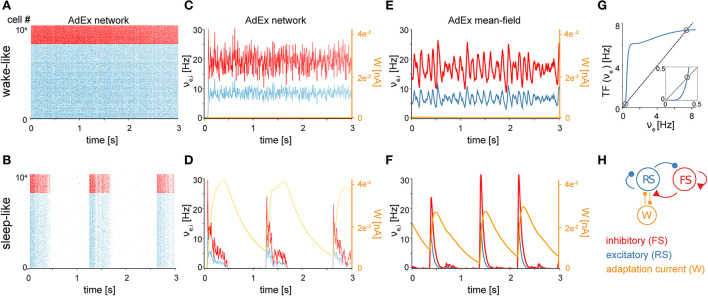Figure 1.
Asynchronous and synchronous dynamics produced by networks of microscopic AdEx neurons and their mesoscopic approximations. Raster plots (A, B) and mean firing rates (C–F) from networks comprised of excitatory RS (blue) and inhibitory FS (red) AdEx neurons displaying asynchronous (A) vs. synchronous states (B) as in Capone et al. (2019) and di Volo et al. (2019). The two simulated states, mimicking wake and sleep neural dynamics, differ only in the spike-frequency adaptation current be provided to the model (be = 0 pA in the asynchronous state and 60 pA in the synchronous state), known to be regulated by neuromodulation in vivo (McCormick, 1992). (C, D) Time variation of mean firing rates (νe,i) and adaptation current (We) corresponding to networks shown in (A, B). Asynchronous (E) and synchronous (F) firing rate dynamics produced using a mean-field model of AdEx networks implemented in The Virtual Brain (TVB). (G) Input-output firing rate relations are given by the mean-field model transfer function (TF). Mean output firing rates of excitatory (blue) neurons as a function of mean excitatory input. The dashed black trace is the identity line. Fixed points of the system (gray circles) occur where the input-output relation intersects with the identity at the positions marked by circles (see Methods for equations). Note that two fixed points are apparent, one at high firing rates and one at low firing rates. The inset is an enlargement of the low-input, low-output region, highlighting the presence of the low-firing fixed point. During asynchronous, wake-like states, firing rates fluctuate around the higher fixed point. During sleep-like states, spike-frequency adaptation builds up as excitatory neurons fire at the high-rate fixed point, eventually destabilizing the high-rate fixed point and causing the system to transition to the near-zero rate fixed point. While the neurons are near-silent, adaptation decays through time, allowing noise fluctuations to entrain a transition back to the high-rate fixed point. (H) Schematic of the simulated network.

